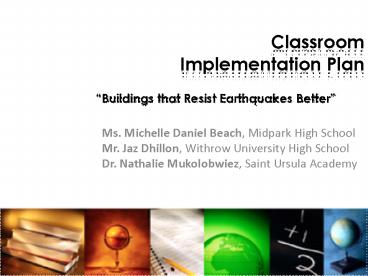Classroom Implementation Plan PowerPoint PPT Presentation
1 / 30
Title: Classroom Implementation Plan
1
Classroom Implementation Plan
Buildings that Resist Earthquakes Better
- Ms. Michelle Daniel Beach, Midpark High School
- Mr. Jaz Dhillon, Withrow University High School
- Dr. Nathalie Mukolobwiez, Saint Ursula Academy
2
The Engineering Design Project
- Students will use the Engineering Design Process
and their knowledge of Simple Harmonic Motion and
Earthquakes to retrofit a single story structure
to resist a low, medium and high frequency
earthquake
3
Rationale (How it relates to Engineering)
- Earthquakes are a natural phenomena that we can
not control - Buildings must be designed or retrofitted to
combat these destructive forces
4
Background Knowledge
- EnGAGE and Explore
5
Background Knowledge
- Earthquake Dynamics
- Seismic Waves
- Simple Harmonic Motion
- natural frequency, period, resonance, stiffness
- Relationship between buildings and mass-spring
systems
6
Instructional Sequence
7
ENGAGE Background Knowledge
8
EXPLORE Background Knowledge
9
EXPLAIN/ELABORATE
10
EVALUATE
11
Project Specifics
- The Engineering Design Project
12
Design
- Use Engineering Design Process to design an
earthquake retrofit system. - Define the Problem
- Brainstorm
- Research and Generate Ideas
- Select an Approach
- Develop a Design Proposal
- Construct Prototype
- Test and Evaluate
- Redesign
- Communicate Results
- Parameters
- The retrofit system must be removable.
- K-nex must be use as the skeleton of your
structure. - The structure cannot be more than _____g.
- The structure must hold _____g on its top floor.
- The structure must be ____x____ at its base to
fit on the shake table.
13
Design Analysis Set-Up
Motion Detector
Force Probe
KNex Single Story Structure
14
Design Analysis
Structural Analysis
Cost Analysis
15
Sample Data Before Retrofit
Force vs. Position
Position vs. Time
- Shows Damping
- Determine natural frequency
- Determine stiffness
- Could calculate the theoretical frequency
16
Testing of Design
- Test retrofit efficiency using shake table
- Efficiency Cost x (1-damage)
- Shake Table Ideas
- Discovery Education http//school.discoveryeducati
on.com/lessonplans/programs/earthquakeproof/ - Manual Shake Table Idea
- Spring
- Frictionless Track
- Pulley
17
Demonstration
- RavBot Shake Table
18
Communication of Design
- Lab Report (Rubric)
- Presentation (Rubric)
- Success and Failures of Design
- Engineering Benefits of their Design
- Cost of Their Design
- Natural Frequency and Damping of their Design
- Efficiency of their Design
19
Objectives
- The Engineering Design Project
20
Students will be able to
- Determine the natural frequency, period, and
resonant frequency of a structure - Analyze the effect of an earthquake retrofit
system (ERS) on stabilization (damping) of a
structure - Predict the effects of ERS on the quality and
quantity of life in the United States - Utilize the engineering design process to make
appropriate choices when designing an ERS - Analyze data to determine the effectiveness of ERS
21
Students will be able to
- Explain how societal issues and considerations
affect the use of ERS in the United States - Solve problems involving unit conversions
(English to Metric) - Describe the movement of the structure using data
tables, graphs and sketches - Derive linear equations that represent the motion
of a structure - Represent free vibration and force vibration as
trigonometric functions and/or exponential
functions
22
Extension Activities
23
Extension Activities
- Smash Lab Video Earthquake Proof House
- Study other vibrations (dancing, marching, wind,
etc.) - Tacoma Narrows Bridge
- Bridge Design Activities
24
References
25
References
- Video Earth Science Earthquakes. Discovery
Channel School. 2002.unitedstreaming. 25 July
2008http//streaming.discoveryeducation.com/ - Guided Readinghttp//mceer.buffalo.edu/infoservi
ce/reference_services/EQaffectBuilding.asp - Seismic Wave Internet Activity
http//www.teachingboxes.org/earthquakes/lessons/
lesson4_supplement/SeismicWaveStudentActivitySheet
.htmhttp//www-rohan.sdsu.edu/rmellors/lab8/l8ma
ineq.htmrwavehttp//www.teachingboxes.org//earth
quakes/resources/haywardFaultAnimations.jsp
- Natural Frequency and Resonance
Labhttp//www.ideers.bris.ac.uk/resistant/resist
_home.html - Mass-Spring Labhttp//phet.colorado.edu/simulati
ons/sims.php?simMasses_and_Springs - Motion Detector Lab(s)Exploring Physics with
PASCO Technology CJ13 SHM Simple Pendulum
Student VersionPhysics, 6th Edition, Cutnell
and Johnson - Exploring Physics with PASCO Technology CJ12
SHM Mass on a Spring Student VersionPhysics,
6th Edition, Cutnell and Johnson - Earthquake Retrofit Projecthttp//www.ciese.org/
curriculum/musicalplates3/en/teacherenrichment5.sh
tmlhttp//rubistar.4teachers.org/index.phphttp/
/teach-nology.com/web_tools/rubrics/presentation/
26
Acknowledgements
- Dr. Anant Kukreti (PI), Professor Associate
Dean for Engineering Education Structural
Engineering, University of Cincinnati - Dr. Kelly Cohen (PI), Associate Professor of
Aerospace Engineering Engineering Mechanics,
University of Cincinnati - Mr. Ravi Chalasani, PhD Student of Civil and
Environmental Engineering, University of
Cincinnati - Ms. Chelsea Sabo, Graduate Assistant of Aerospace
Engineering Engineering Mechanics, University
of Cincinnati - Dr. Richard Gass, Assistant Professor of Physics,
University of Cincinnati - Mr. W. Henry Leach, Technical Professional of
Physics, University of Cincinnati - RET Teachers Site for Civil Infrastructure
Renewal and Rehabilitation. National Science
Foundation Grant ID EEC 0601960, Dept. of Civil
and Environmental Engineering, University of
Cincinnati.
27
Questions?
- Thank you.
28
OHIO Standards
- 11-12 Grade
29
Science
- Physical Science
- D. Apply principles of forces and motion to
mathematically analyze, describe and predict the
net effects on objects or systems. - Science and Technology
- A. Predict how human choices today will
determine the quality and quantity of life on
Earth. - Scientific Inquiry
- A. Make appropriate choices when designing and
participating in scientific investigations by
using cognitive and manipulative skills when
collecting data and formulating conclusions from
the data. - Scientific Ways of Knowing
- C. Explain how societal issues and
considerations affect the progress of science and
technology.
30
Mathematics
- Measurement Standard
- A. Solve problems involving unit conversion for
situations involving distances, areas, volumes
and rates within the same measurement system. - Patterns, Functions and Algebra Standard
- A. Describe problem situations (linear,
quadratic and exponential) by using tabular,
graphical and symbolic representations. - B. Find linear equations that represent lines
that pass through a given set of ordered pairs,
and find linear equations that represent lines
parallel or perpendicular to a given line through
a specific point.

